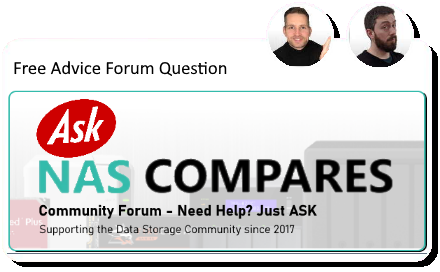03-07-2025, 09:07 AM
Great choice with the Terramaster F4-423! Since you’re looking to get the best performance out of your NAS, you’ll be happy to know that this model actually allows NVMe drives to be used for both storage and caching, which gives you more flexibility.
Best NVMe Setup for Performance
Since your main use case is watching movies, sharing photos, playing music, and backing up devices, here’s what I’d recommend:
Option 1: Use NVMe as a Primary App & Fast Storage Drive (Best for Performance)
Instead of using both NVMe drives for cache, you can set one NVMe as a primary storage pool for apps, metadata, and frequently accessed files (like your Roon/Plex database or music library).
This is especially useful for fast access to thumbnails, photos, or music files without waiting on HDD spin-up times.
The second NVMe could then be used as read cache to accelerate access to media files stored on the HDDs.
Setup:
NVMe 1 (Storage Pool) → Store apps, Plex database, Roon metadata, and high-access files.
NVMe 2 (Read Cache) → Speeds up access to frequently streamed media.
T-RAID with HDDs → Handles bulk storage for large movies, backups, and files.
Option 2: Use Both NVMe Drives for Read/Write Cache (If You Want HDD-Only Storage)
If you want to keep all storage on your HDDs and just use NVMe to speed things up:
One NVMe as Read Cache → Faster access to frequently played movies and music.
One NVMe as Write Cache → Absorbs backup writes, improving transfer speeds.
Your T-RAID Storage Setup
Since you have:
2x 10TB WD Black (7200RPM) HDDs
2x 4TB HDDs
You can use T-RAID to:
Mix all HDDs into a single pool with redundancy (instead of being forced into strict RAID configurations).
Expand easily in the future by adding more drives of different sizes.
Future-Proofing for 10GbE
Since you plan to upgrade to 10GbE networking, the best long-term setup would be:
Primary storage on NVMe (for high-speed access).
HDDs in T-RAID for bulk storage (media, backups).
10GbE will unlock the full potential of NVMe storage for network transfers.
Best NVMe Setup for Performance
Since your main use case is watching movies, sharing photos, playing music, and backing up devices, here’s what I’d recommend:
Option 1: Use NVMe as a Primary App & Fast Storage Drive (Best for Performance)
Instead of using both NVMe drives for cache, you can set one NVMe as a primary storage pool for apps, metadata, and frequently accessed files (like your Roon/Plex database or music library).
This is especially useful for fast access to thumbnails, photos, or music files without waiting on HDD spin-up times.
The second NVMe could then be used as read cache to accelerate access to media files stored on the HDDs.
Setup:
NVMe 1 (Storage Pool) → Store apps, Plex database, Roon metadata, and high-access files.
NVMe 2 (Read Cache) → Speeds up access to frequently streamed media.
T-RAID with HDDs → Handles bulk storage for large movies, backups, and files.
Option 2: Use Both NVMe Drives for Read/Write Cache (If You Want HDD-Only Storage)
If you want to keep all storage on your HDDs and just use NVMe to speed things up:
One NVMe as Read Cache → Faster access to frequently played movies and music.
One NVMe as Write Cache → Absorbs backup writes, improving transfer speeds.
Your T-RAID Storage Setup
Since you have:
2x 10TB WD Black (7200RPM) HDDs
2x 4TB HDDs
You can use T-RAID to:
Mix all HDDs into a single pool with redundancy (instead of being forced into strict RAID configurations).
Expand easily in the future by adding more drives of different sizes.
Future-Proofing for 10GbE
Since you plan to upgrade to 10GbE networking, the best long-term setup would be:
Primary storage on NVMe (for high-speed access).
HDDs in T-RAID for bulk storage (media, backups).
10GbE will unlock the full potential of NVMe storage for network transfers.





